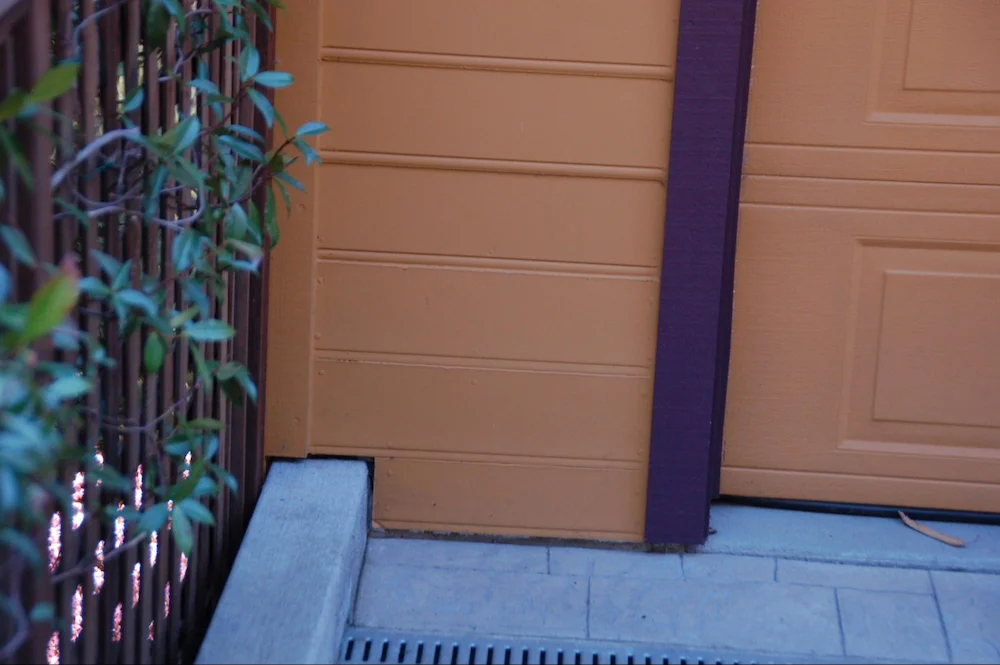Appearance
Siding Clearance
Bottom line
Combustible siding components must have a minimum of six inches of noncombustible vertical clearance measured from any horizontal surface they interface with in order to protect against debris accumulation and ember ignitions at the base of walls.
Overview
Structures with combustible siding or sheathing materials are vulnerable to ignition from embers that can accumulate at the base of exterior walls. These embers can also ignite combustible materials located near the structure, which can expose the siding to flame impingement and / or radiant heat. For this reason, the 6-inch noncombustible vertical zone must be paired with a well maintained Zone 0 near the structure.
Siding clearance applies to any horizontal-to-vertical interface where the vertical siding or component in the wall assembly is combustible (e.g., wood-based sheathing product behind fiber cement). Siding clearance goes hand-in-hand with siding mitigations and shares commonalities with chimneys, complex roof locations, and decks as well as some doors.
Mitigation options include installing metal flashing to achieve 6 inches of noncombustible vertical clearance or replacing one or more of the lower courses of combustible siding materials with noncombustible options (e.g., fiber cement) to provide at least 6 inches of noncombustible vertical clearance.
Noncombustible vertical clearance
Measure the distance between the top of the horizontal surface that intersects the structure’s siding (e.g., ground) and note whether noncombustible vertical clearance is less than six inches.
Siding material
For help determining siding materials, refer also to the Siding section.
Brick or masonry
A brick or masonry facade mitigates siding clearance ignition risks by virtue of being noncombustible provided that good Zone 0 is maintained
Walls with partial brick or masonry facades where a final course of brick forms a 2-6 inch ledge before transitioning to combustible siding material can be cause for concern if it occurs within 18 inches of a horizontal surface (e.g., ground, deck, patio). Above this height, wind dynamics will drive debris and ember accumulation at the base of the structure or in the eave area.
Wood
Combustible wood siding within six inches of the ground must be mitigated.
Vinyl
Combustible vinyl siding within six inches of the ground must be mitigated.
Fiber cement
Fiber cement is a noncombustible material that mitigates siding clearance ignition risks; however, wood-based sheathing behind the fiber cement cladding often overhangs the foundation or stem wall and can be the vulnerable component in the wall assembly if siding comes within six inches of the ground. If wood sheathing materials behind fiber cement siding are present in the six inch noncombustible vertical area, then it must be mitigated.
 The lower two courses of wood (hardboard) siding have been replaced with a fiber cement product and painted to match. In this case, two courses of combustible siding were removed and replaced with a fiber-cement option that had a similar pattern.
The lower two courses of wood (hardboard) siding have been replaced with a fiber cement product and painted to match. In this case, two courses of combustible siding were removed and replaced with a fiber-cement option that had a similar pattern.
Metal
Noncombustible aluminum or other metal siding mitigates siding clearance ignition risks.
Stucco
Stucco is a noncombustible material. It is common in Southern California and consists of plaster materials applied in successive layers on top of a wire lattice (e.g., chicken wire) to provide a substructure.
Other combustible
Any combustible siding material within six inches of a horizontal surface must be mitigated.
Other noncombustible
Other noncombustible siding materials not listed above can mitigate siding clearance ignition risks.
Length of clearance issue
If noncombustible vertical clearance from a horizontal surface is less than six inches, estimate the length of the siding section that is non-compliant. This is used to help estimate the cost to mitigate.